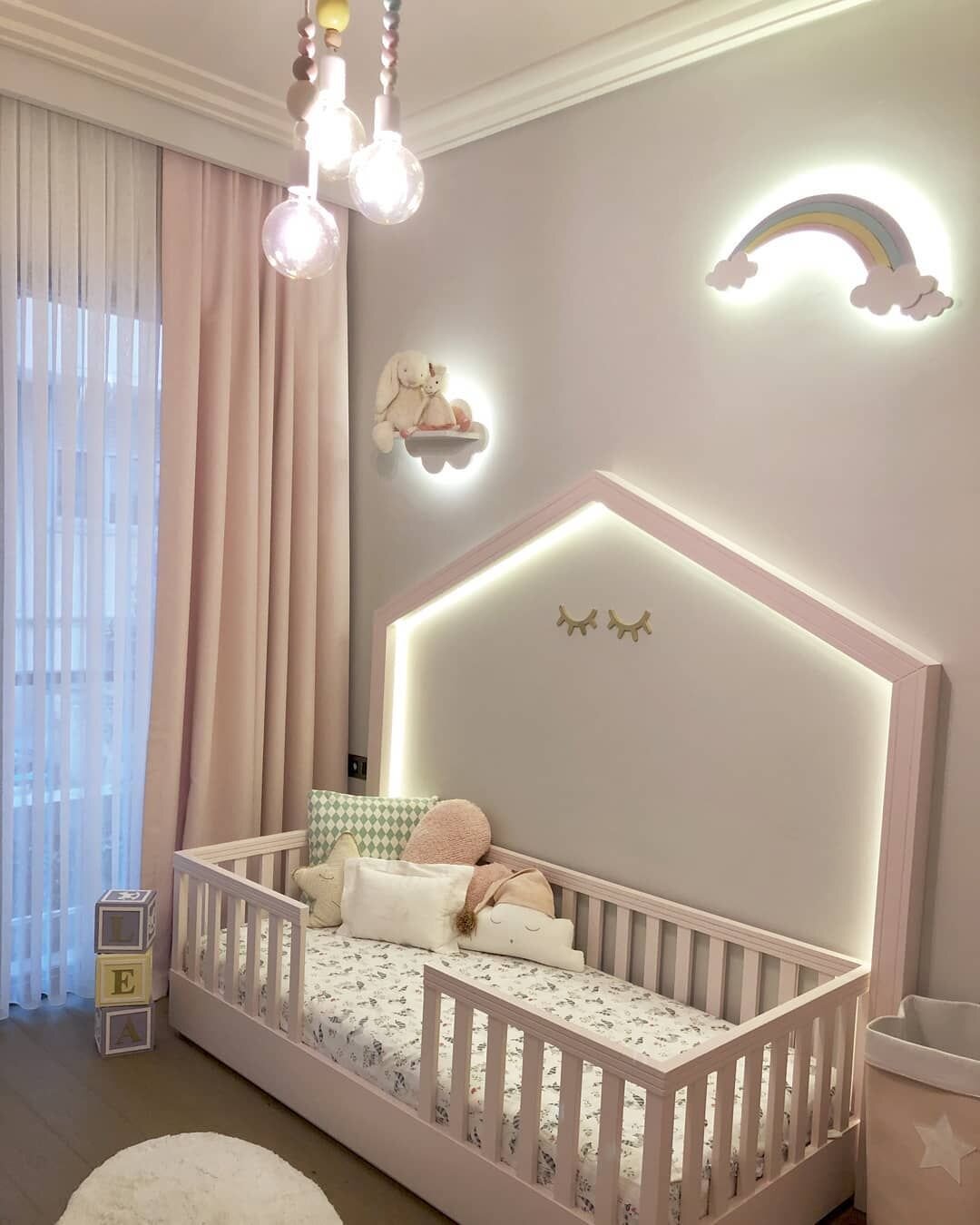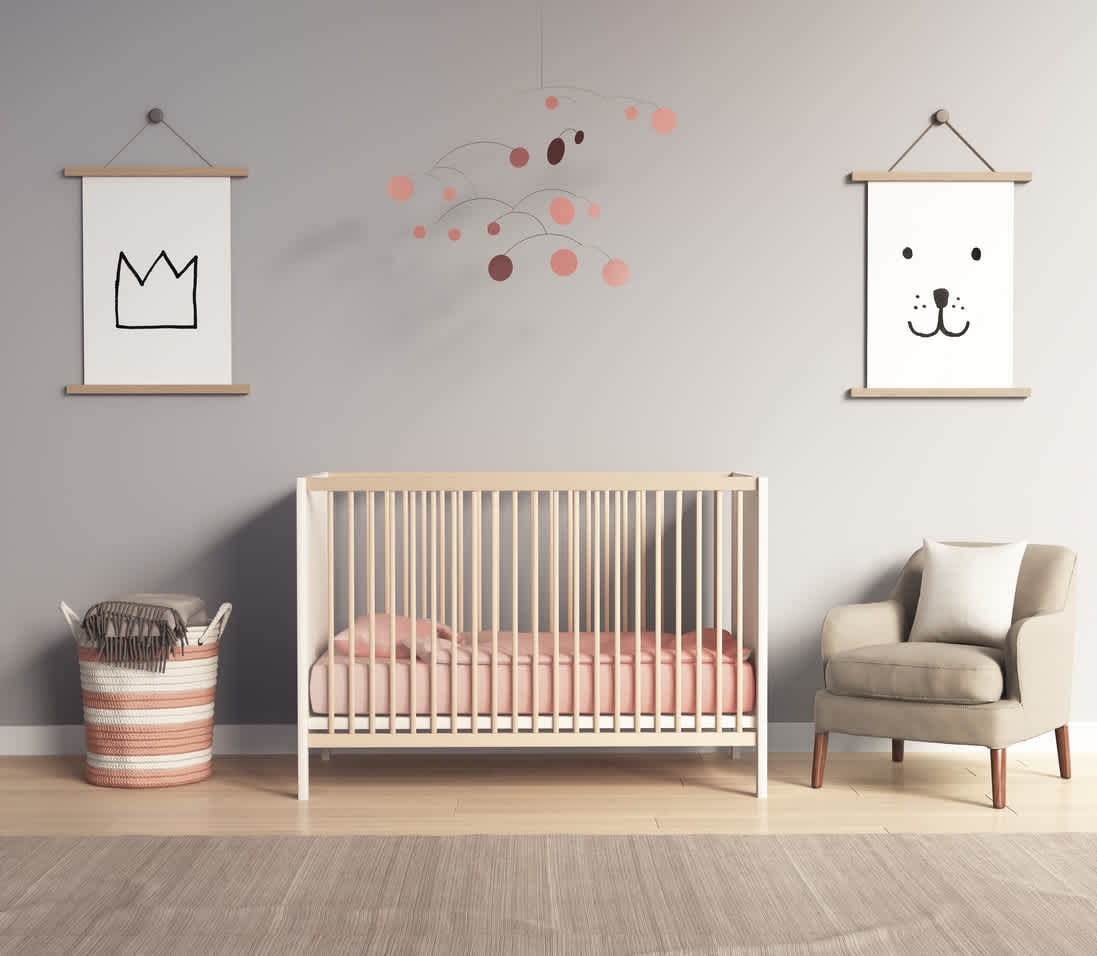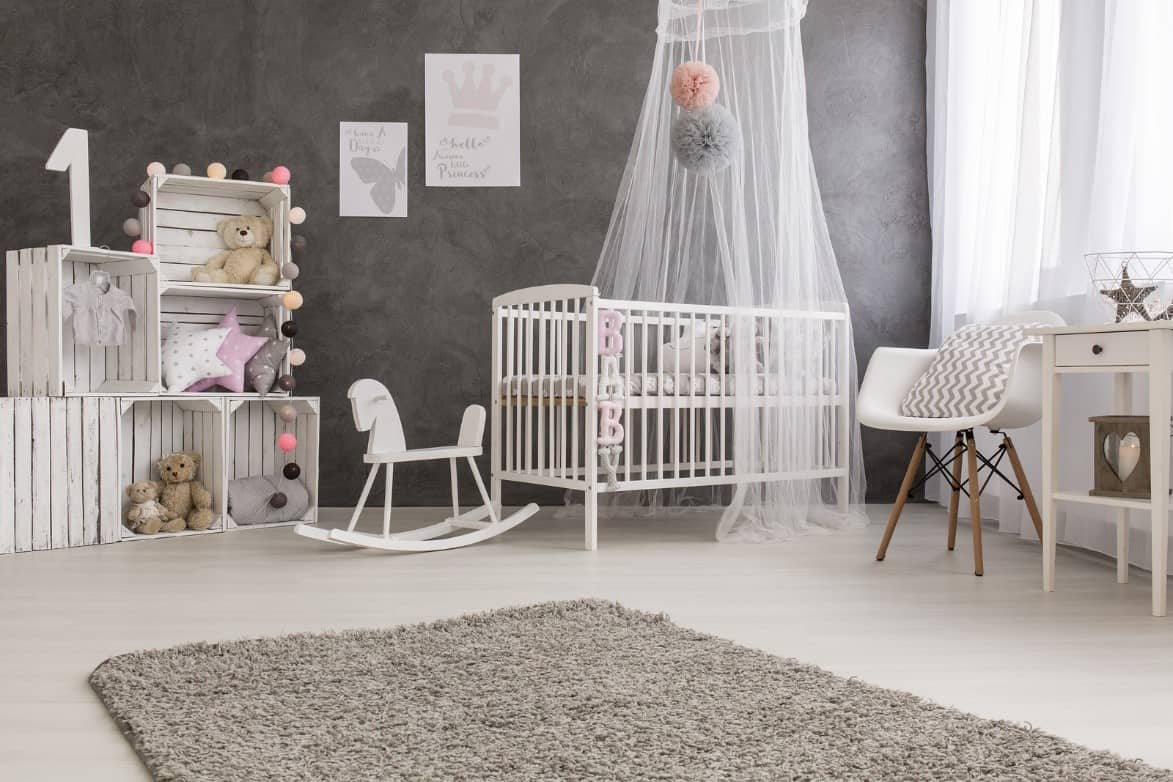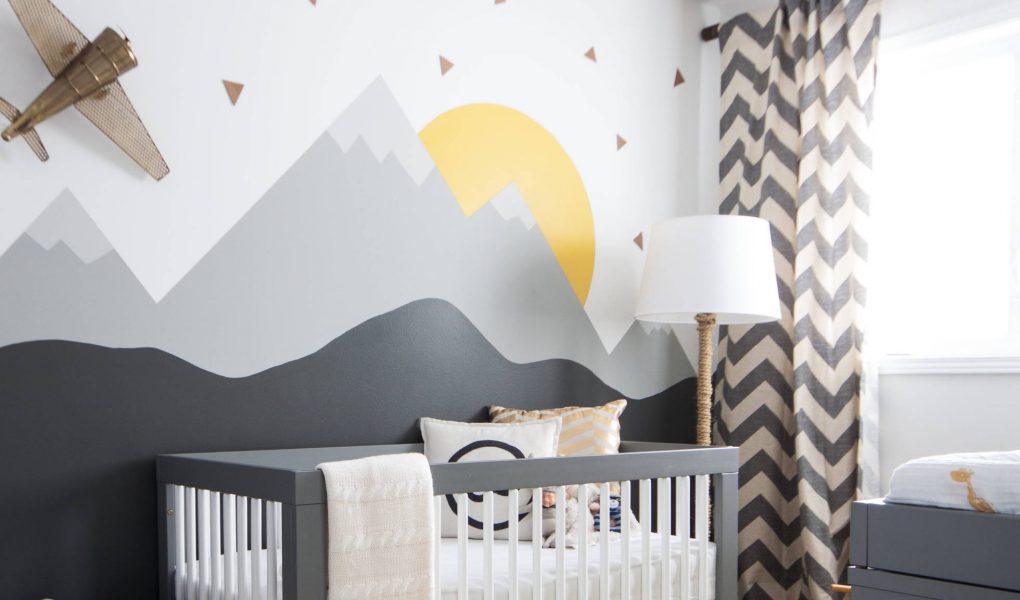A. What should you not put in a baby’s room?

When setting up a baby’s room, it’s important to create a safe and comfortable environment. However, there are several items that should be avoided to ensure the well-being of your child. These can include items that can pose a choking hazard, emit dangerous chemicals or fumes, or cause injury. It is crucial to consider the potential risks and eliminate them from your baby’s room.
Here are 15 items that experts generally advise against having in a baby’s room:
1. Loose bedding or pillows
Loose bedding, such as blankets, quilts, and pillows, can pose a suffocation risk to a baby. It’s recommended to use fitted sheets and sleep sacks instead. In addition, it’s important to ensure that the baby’s face is never covered by these items and that the baby is always placed on his or her back to sleep.
2. Cords or strings that can cause strangulation
Cords or strings, such as window blind cords or the strings on toys, can pose a serious strangulation hazard to a baby. It’s important to secure these items out of reach or to choose products that do not have cords. It’s also important to regularly inspect the room for any potential hazards and remove them promptly.
3. Window blinds with cords

Window blinds with cords can pose a serious strangulation hazard to a baby. It’s recommended to choose cordless window coverings or to secure the cords out of reach. If you have corded blinds in your baby’s room, it’s important to ensure that the cords are always kept taut and out of reach. Additionally, it’s a good idea to consider installing cord stops, which prevent the cords from becoming tangled or stretched.
4. Candles or other open flames
Candles and other open flames, such as oil lamps or incense, should be avoided in a baby’s room. Not only can these items start fires, but they can also emit fumes that can be harmful to a baby’s health. Instead, opt for electric lighting options, such as night lights or wall-mounted fixtures. Additionally, it’s important to keep anything flammable, such as curtains or bedding, away from heat sources to reduce the risk of fire.
5. Chemical air fresheners or plug-ins
Chemical air fresheners or plug-ins emit fumes that can be harmful to a baby’s health, particularly if they are used frequently or in a small, enclosed space like a nursery. Some of the chemicals found in these products have been linked to respiratory problems, headaches, and other health issues. Instead, opt for natural air fresheners like essential oils or potted plants, or simply open a window to let in fresh air.
6. Wall hangings that can fall off and cause injury

Loose or dangling wall hangings can pose a risk of injury to babies if they fall off and hit the baby or if the baby pulls on them. To minimize this risk, it is recommended to:
- Secure all wall hangings and decorative items to the wall with appropriate hardware and anchors.
- Avoid hanging heavy or bulky items, such as picture frames or large mirrors, in the baby’s room.
- Keep all cords, wires, and strings that are connected to wall hangings out of reach of the baby.
- Consider removing or relocating any wall hangings or decorative items that could easily fall off or become a tripping hazard.
By following these guidelines, you can help ensure that the baby’s room is free from any potential hazards that could cause injury.
7. Sharp or heavy objects that can cause injury
Sharp or heavy objects can cause serious injury if handled or stored improperly. To minimize the risk of injury, it is important to:
- Keep sharp objects, such as knives, scissors, and power tools, out of reach of children.
- Always handle sharp objects with care, keeping them pointed away from yourself and others.
- Store sharp objects in a safe, secure place when not in use.
- Use proper protective equipment, such as gloves, when handling heavy objects.
- Ask for help or use proper equipment, such as a dolly, when moving heavy objects to avoid strain or injury.
By following these guidelines, you can help reduce the risk of cuts, punctures, and other types of injury from sharp or heavy objects.
8. Electric heaters or fans

Electric heaters and fans can pose safety hazards if used improperly. To ensure safety when using electric heaters, it is important to:
- Use heaters that are certified by a recognized testing laboratory and meet the applicable safety standards.
- Place heaters on level, flat surfaces, away from flammable materials, such as curtains, bedding, and paper.
- Never leave heaters unattended and always turn them off when leaving the room or going to bed.
- Keep heaters away from water, as water and electricity can be a dangerous combination.
a. When using electric fans, it is important to:
- Make sure the fan is properly grounded.
- Keep the fan away from water.
- Avoid touching the fan with wet hands.
- Regularly inspect the fan for frayed wires, loose parts, and other signs of damage, and replace the fan if necessary.
By following these guidelines, you can help reduce the risk of fire, electric shock, and other safety hazards associated with electric heaters and fans.
9. Any type of toys or items that can cause choking
Babies and young children are at risk of choking on small toys or items that they might put in their mouths. To minimize this risk, it is important to keep the following types of toys or items out of reach of babies:
- Small toys or toy parts that are small enough to fit inside a toilet paper roll.
- Round or cylindrical objects, such as balls, marbles, and buttons, which can easily get stuck in a baby’s throat.
- Stuffed toys or toys with small parts, such as eyes or noses, that can come off and be swallowed.
- Latex balloons, which can pop and cause small pieces to be inhaled.
- Long, thin objects, such as pencils or straws, which can get stuck in a baby’s windpipe.
It is also a good idea to supervise young children while they play, to help prevent choking incidents. By taking these precautions, you can help keep babies and young children safe from choking hazards.
10. Plastic bags, which can cause suffocation

Plastic bags can pose a serious suffocation risk to children and should be kept out of reach. To prevent suffocation from plastic bags, it is important to:
- Keep all plastic bags, including grocery bags and food storage bags, away from children.
- Store plastic bags in a secure place, such as a cabinet or a pantry, that is out of reach of children.
- Dispose of plastic bags properly, such as tying them in knots before throwing them in the trash.
- Avoid leaving plastic bags lying around the house, especially in areas where children play.
- Teach children about the dangers of playing with plastic bags and why they should never put them over their heads or play with them unsupervised.
By following these guidelines, you can help reduce the risk of suffocation from plastic bags and keep children safe.
11. Overstuffed furniture or bean bag chairs
Overstuffed furniture, such as sofas and bean bag chairs, can pose a suffocation risk to small children if they become trapped inside. To minimize this risk, it is important to:
- Choose furniture that has a tight, sturdy structure and doesn’t easily collapse.
- Place furniture away from windows and doorways to prevent children from becoming trapped inside.
- Avoid using oversized bean bag chairs or bean bag furniture that can easily engulf a child.
- Keep an eye on children when they are playing near overstuffed furniture, and never leave them unattended.
By following these guidelines, you can help reduce the risk of suffocation from overstuffed furniture and bean bag chairs and keep children safe.
12. Tall furniture such as bookshelves that can tip over

Tall furniture, such as bookcases and shelves, can pose a risk of tipping over if not secured properly. To prevent these types of accidents, it is important to:
- Choose sturdy furniture with a low center of gravity and sturdy legs or base.
- Secure furniture to the wall using wall brackets, braces, or anchors to prevent tipping.
- Do not overload shelves or bookcases with heavy items, as this can increase the risk of tipping.
- Keep items on lower shelves within reach of children, so they don’t have to climb to get them.
- Regularly inspect furniture to ensure that it is still secure and stable, and make any necessary adjustments or repairs.
By following these guidelines, you can help prevent tall furniture from tipping over and reduce the risk of injury.
13. Any type of toxic or chemical cleaners
Toxic or chemical cleaners can pose serious health risks if not handled or stored properly. To minimize the risk of injury or exposure, it is important to:
- Read and follow the instructions on the label of all chemical cleaners, including warnings and precautions.
- Store toxic cleaners in a secure place, out of reach of children and pets.
- Avoid mixing different types of cleaners, as this can create dangerous chemicals or fumes.
- Wear protective equipment, such as gloves and goggles, when handling toxic cleaners.
- Ventilate the area well when using toxic cleaners, and avoid breathing in the fumes.
It is also a good idea to use non-toxic or eco-friendly cleaners whenever possible, as these can be safer and gentler for both people and the environment. By following these guidelines, you can help reduce the risk of injury or exposure to toxic or chemical cleaners.
14. Smoke detectors that are not functioning properly

Smoke detectors are an essential safety device that can help protect against fire and smoke. However, if they are not functioning properly, they can become a hazard in themselves. To ensure that smoke detectors are working effectively, it is important to:
- Install smoke detectors on every level of your home and near sleeping areas.
- Test smoke detectors regularly to ensure that they are working properly.
- Replace smoke detectors when they are more than 10 years old or when they start to make strange noises.
- Keep smoke detectors free from dust and debris, and vacuum or dust them regularly.
- Replace batteries in smoke detectors at least once a year or when the low-battery indicator sounds.
By following these guidelines, you can help ensure that your smoke detectors are working properly and provide maximum protection against fire and smoke.
15. Chemical insecticides or bug sprays
Chemical insecticides and bug sprays can pose serious health risks if not handled or stored properly. To minimize the risk of injury or exposure, it is important to:
- Read and follow the instructions on the label of all insecticides and bug sprays, including warnings and precautions.
- Store insecticides and bug sprays in a secure place, out of reach of children and pets.
- Wear protective equipment, such as gloves and a mask, when handling insecticides and bug sprays.
- Ventilate the area well when using insecticides and bug sprays, and avoid breathing in the fumes.
- Keep the spray nozzle pointed away from your face and other people when applying the product.
It is also a good idea to use non-toxic or eco-friendly insecticides or bug sprays whenever possible, as these can be safer and gentler for both people and the environment. By following these guidelines, you can help reduce the risk of injury or exposure to chemical insecticides and bug sprays.
16. Conclusion
In conclusion, creating a safe and secure environment for your baby is essential to ensure their well-being and health. To this end, experts generally advise against having items in a baby’s room that can pose a risk of injury or exposure to potential hazards. By following these guidelines, you can help create a safe and secure environment for your baby and minimize the risk of injury or exposure to potential hazards.
